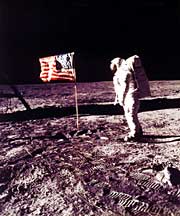The mirrors placed by the astronauts on the moon continue to provide a scientific return to this day - an accurate measurement of the distance from the earth to the moon
23.1.2002
From: New York Times

The first expedition to the moon, '69. The experiments continue to this day
The future settlers on the moon could consider holding an auction of the selection of scrap souvenirs, left behind by the Apollo missions. Among the items: the underside of the six expeditions' landing vehicles, three all-terrain vehicles, surface sampling equipment, seismographs, television cameras and even a golf ball.
However, there are three items that should be marked with a "not for sale" label. These are mirrors, placed by the astronauts of the first three missions, designed to return a beam of light to its source with great precision.
The experiment in which these "retroreflectors", as the mirror machines are called, was used, is the only one among the experiments of the Apollo missions that is still being carried out. Along with a similar mirror left behind by an unmanned Soviet expedition, the mirrors are used in distance measurement experiments using laser beams, in which a powerful laser flash is sent through a telescope, reflected in the mirrors and received back at the source.
Based on the time it takes for light to travel to the moon and back, precise measurements can be made of the distance between the Earth and the moon and the gravitational effects on each. Because even a laser beam diverges considerably at distances of this magnitude, only single photons of light are absorbed at the receiving end. Over the years, as laser technology and telescopes improved, the measurements became more accurate.
The latest experiments using "retroreflectors" are starting now. They are made by researchers from the University of Washington, who use a telescope with a diameter of about 3.7 meters at "Apache Point" in New Mexico. Considering the size of the telescope and improvements in the technology that allows the reception of the reflected signal, the researchers hope to make the most accurate measurements to date. Among other things, they hope to reduce the uncertainty regarding the distance between the Earth and the Moon, which is currently estimated to be on the order of two and a half centimeters. The researchers hope to reduce the uncertainty to a tenth of a centimeter or even less.

One response
Is there no other way of housing down to the millimeter other than the laser and mirrors on the moon.